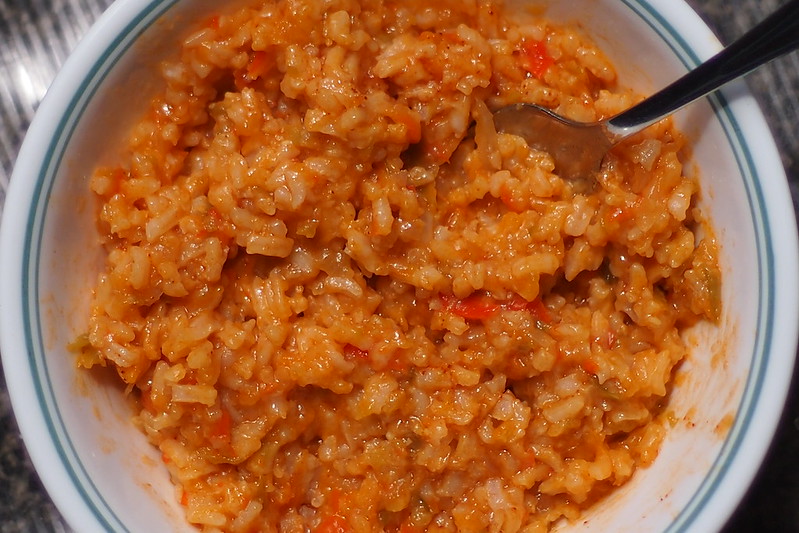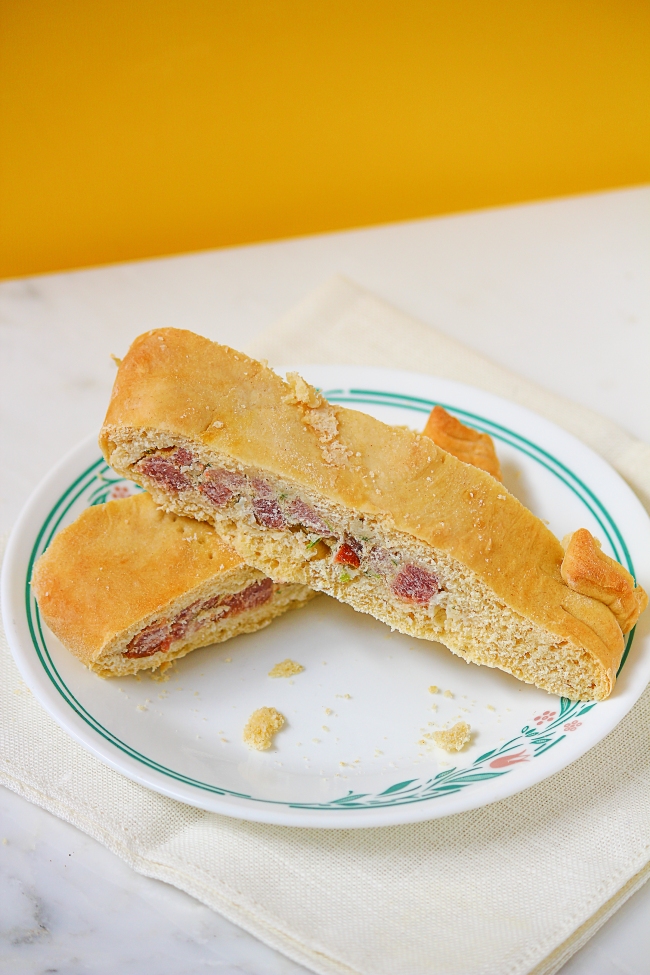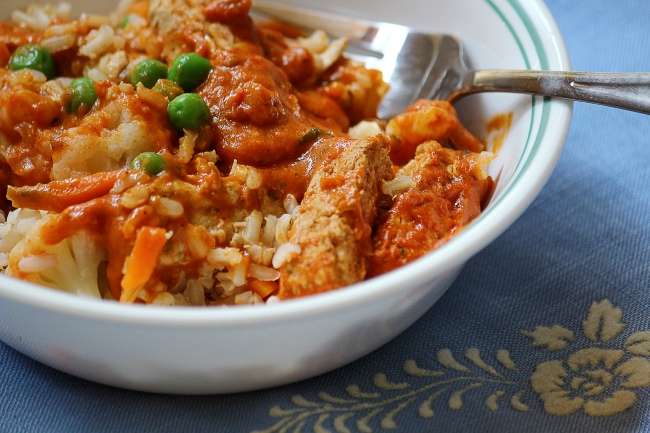A few nights ago, the Chef and I made a new recipe for Spanish Rice. I'll rather sheepishly admit that up until this point we used Knorr's Spanish rice but the recipe was changed recently and we were really disappointed. Later we found we were not alone, apparently some people are SO upset that they have taken to Knorr's facebook page with their thoughts.
We just cut our losses and admitted that we probably shouldn't have been eating packaged crap anyway. So the Chef had a recipe he'd been wanting to try with lots of fresh veggies.
It was very tasty but sadly one of those foods that just don't photograph well.
Spanish Rice
Ingredients:
- 1 Green Bell Pepper, chopped
- 1 Red Bell Pepper, chopped
- 2 Rib of Celery, chopped
- 2 medium sized Onions, chopped
- 1/4 Cup Olive Oil
- 3 Cloves of Garlic
- 8 Ounces Tomato Sauce
- 1 Cup Long Grain White Rice
- 1 Cup Water (for Rice)
- 1 tsp Salt
- 1/4 tsp Cayenne Pepper
- 2 tsp Cumin
Chop all vegetables and saute in the oil in a large pan for about 5 minutes on medium heat. Add the sauce, rice, water, and spices and bring to a boil. Reduce heat to low and cover for 20 minutes, stirring occasionally. It is done when the majority of the liquid has been absorbed by the rice.
Hope you enjoyed this! Now we have something yummy and full of veggies to accompany our vegetarian tacos.
It's Really Dark in Your House, Trust Me: Lighting for Food Photography
Photography is the capture of light. Beautiful light makes beautiful photos. The best light for photography is generally natural sunlight during the morning or the afternoon. Many photographers will buy their house based on how good the light is onside and if it has huge north facing windows, known for their great light. Those of us not gifted by the architecture gods need to augment the light inside our house for photography.
But if you don't have a lot of money for professional lighting, fear not! There is a simple solution: Shoot outdoors. Don't be afraid to leave your kitchen. Yes, your neighbors are going to look at you like you've lost your marbles, and lets be realistic, they never liked you anyway. Your photos will thank you.
Remember:
-Find a spot that you can use undisturbed.
-Try and find a spot with some shade so it evenly lights your food. Bright sunlight can create harsh shadows on the food that isn't appetizing. Even in the shade, it will be brighter than shooting in a dark room.
-Choose and correct white balance or set a custom white balance if your camera has the option, most DSLRs do. The white balance will be different than what you were using inside.
Improve Your Food Photography!: Understanding White Balance
White balance is more important to food photography than most other types of photography.
In photos of food an incorrect color cast can be the difference between scrumptious and save-me-from-this-horrible-meal-that-my-mother-cooked.
So what is white balance? White balance is the compensation that we must make in our cameras to accurately represent the scene our eyes see. When light shines on a scene, the temperature of the light will create a cast on what we are looking at. Warmer lights leave a red or orange tint and cooler lights leave a bluer tint.
Our eyes are very sophisticated organs. When we look at a scene our eyes will automatically adjust for the color cast of the light on the scene and we won't even notice it was there. This is the reason that something that looked beautiful in the kitchen might have a dingy tinge to it on the computer.
Most cameras have an option for you to change the while balance to match the settings. Auto white balance typically works well outdoors but not well indoors. The settings in most cameras include an option for Full Sun, Cloudy, Shade, Florescent, Tungsten, Flash, or similar settings.
Make sure you are using the option that makes the whites in your photo, look white on the screen.
If you are having a hard time finding which setting is the best, take a white napkin or plate and try each of the different settings until the white looks whitest on the screen.
More Resources:
- Fantastic White Balance Tutorial from Spicie Foodie
- Tips for DSLR shooters and White Balance by Nicolesy.
In photos of food an incorrect color cast can be the difference between scrumptious and save-me-from-this-horrible-meal-that-my-mother-cooked.
So what is white balance? White balance is the compensation that we must make in our cameras to accurately represent the scene our eyes see. When light shines on a scene, the temperature of the light will create a cast on what we are looking at. Warmer lights leave a red or orange tint and cooler lights leave a bluer tint.
Our eyes are very sophisticated organs. When we look at a scene our eyes will automatically adjust for the color cast of the light on the scene and we won't even notice it was there. This is the reason that something that looked beautiful in the kitchen might have a dingy tinge to it on the computer.
Most cameras have an option for you to change the while balance to match the settings. Auto white balance typically works well outdoors but not well indoors. The settings in most cameras include an option for Full Sun, Cloudy, Shade, Florescent, Tungsten, Flash, or similar settings.
Make sure you are using the option that makes the whites in your photo, look white on the screen.
If you are having a hard time finding which setting is the best, take a white napkin or plate and try each of the different settings until the white looks whitest on the screen.
More Resources:
- Fantastic White Balance Tutorial from Spicie Foodie
- Tips for DSLR shooters and White Balance by Nicolesy.
Is your Kitchen Ugly? Cheap Backgrounds for Food Photography
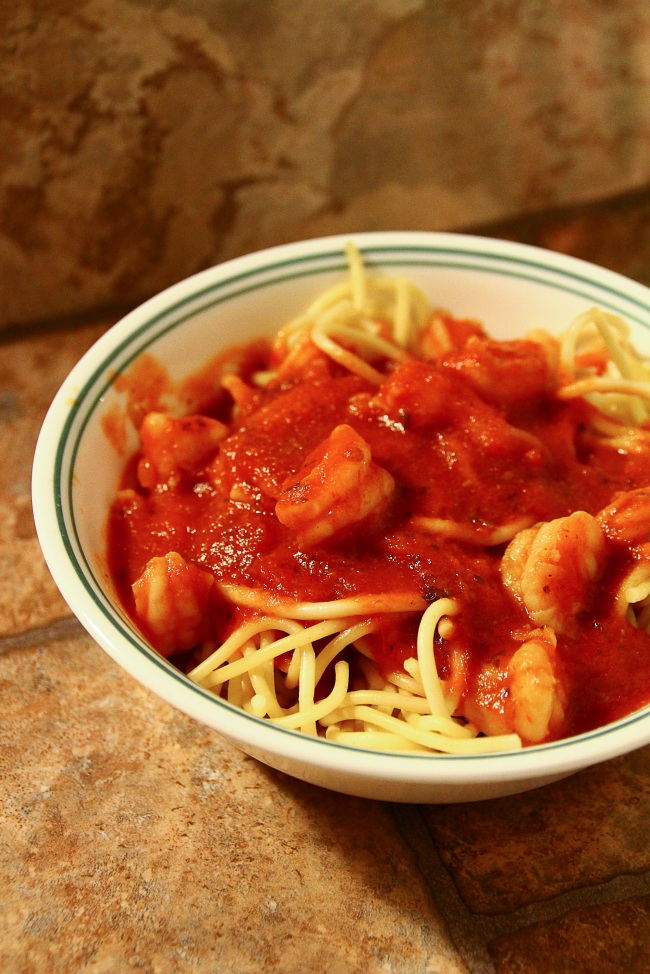 Is your kitchen ugly? Are you upset you don't have 1,000 exotic locations to shoot in? My kitchen is very ugly. It really is. Not only are the counter tops made of glittery, yellow Formica, but they match the backslash and the floor. Any photo taken in the kitchen has a sickly yellow cast. It's very unappealing for food photography.
Is your kitchen ugly? Are you upset you don't have 1,000 exotic locations to shoot in? My kitchen is very ugly. It really is. Not only are the counter tops made of glittery, yellow Formica, but they match the backslash and the floor. Any photo taken in the kitchen has a sickly yellow cast. It's very unappealing for food photography.Never fear. Those of us stuck with cringe worthy cooking arrangements don't have to let that get in the way of our photography. There are cheap and easy tools that can be used to transform your photos.
Use other rooms: Try taking photos in rooms other than in the kitchen. Many people have pretty wood tables in their dining room that make for nice backgrounds. Alternatively, some people take great photos on the tiles in their bathrooms.
Don't use tables: We always think about keeping food on the table but great photos are to be had when you think off the tables. Your deck, chairs in your house, carpets, or floors can look great in a photo. Few people will even recognize that your photo was taken someplace strange.
Use paper: A nice, cheap way to have dozens of different backdrops is to buy a book of patterned scrapbooking paper. These can be bought for under $10 and offer hundreds of different color combinations. Wrapping paper can also be a good backdrop. If you find a pattern you really like, buy multiple sheets of it as it is likely to be ruined being around the food.
Utilize the hardware store. The photo at the top of this page was taken on two stick-on, 59 cent flooring. Individual tiles, wood paneling, wood scraps etc. can be used to mimic nice tables.
- Tutorial for plywood backgrounds.
- Tutorial for stressed faux wood tabletop.
- Great website on backgrounds.
Hope this was helpful! Any tips or tricks you use?
More Resources:
- Backgrounds by I Breathe and I'm Hungry
-DIY Photography boards by Meal Makeover Moms' Kitchen
The Best Camera for Food Photography
What camera should I buy? That's a question that gets asked a lot and unfortunately, there's no simple answer.
Cameras can be divided into 3 basic groups:
Point and Shoots
A Point and Shoot camera is one where you just aim the camera at the subject and click the shutter button. The camera figures out what it believes to be the best setting for your shot based on the data it receives. Most of these are consumer grade cameras, designed to fit in your pocket. Many of these cameras have settings such as "macro," "landscape," "portrait," etc. and are getting more sophisticated every year. These cameras typically have a small sensor, the part that records the image, which means image quality can be affected. The main advantage of a Point and Shoot is the convenience and potability. Price: $
DSLRs
DSLRs are digital cameras that have manual settings so that the photographer chooses the best setting for each image. DSLR stands for "Digital Single-Lens Reflex" which is just the method used by the camera to reflect the image into the viewfinder. The main draw of these cameras are the manual controls and bigger sensors. Most professionals use DSLRs. DSLRs are must haves if you will be wanting to print your photos large with high resolution or shoot in low light situations, like a dark restaurant.
DSLRs typically give better image quality due to their large sensors, manual controls and better lenses and accessories that can be used with them. For some people extra lenses and accessories can be too much of a hassle and too costly. If you want to shoot sports, you might will need a different lens than if you want to shoot portraits. Price: $$$$
Bridge Cameras
Bridge cameras are a new group created in recent years. These cameras fall in between Point and Shoots and DSLRs. These are a good choice for bloggers who want better photos but can't spend upwards of $1,500 on a low end, consumer DSLR. Many bridge cameras have a sensor bigger than a Point and Shoot but smaller than a DSLR so quality is usually good enough for web purposes. Price: $$-$$$
Mirrorless cameras and Micro 4/3 cameras works similarly to DSLRs, they just lack the viewfinder system. You still need to buy separate lenses and accessories for these. If you are only doing one type of photography, like food photography, you probably can get away with just using one lens so these don't have to be too costly.
Superzooms have all of the lenses you might need in one. They are very advanced point and shoots with some manual controls. If you are only using your camera to shoot food a superzoom may be overkill in lens reach, but if you are also using it for trips to the zoo and photos of your family, this one is probably the best type to get. Image quality is not typically as good as a Mirrorless camera but it is good enough for web content.
Other things to look for:
Megapixels don't always matter. To photographers this is known as the Megapixel Myth. So don't feel pressured to buy the latest and greatest based on the megapixel count.
Make sure the camera will be able to do everything you need it to do. Make a list of everything you will be taking photos and see how each individual camera model can accommodate your list. Remember, you should go a camera store and test out the models to see what you like best. Don't feel pressured by the salesperson. They will likely try to sell you "more camera" than you need.
Here are some good camera review sites to help you get started:
Hope this was helpful to the beginner. If you have any questions, please comment them in the box below. Also, if you are someone who already shoots food, please comment what you shoot with below.
Cameras can be divided into 3 basic groups:
- "Point and Shoots"
- DSLRs, and SLRs
- Bridge Cameras, Mirrorless cameras, Micro 4/3, Super Zooms
Point and Shoots
A Point and Shoot camera is one where you just aim the camera at the subject and click the shutter button. The camera figures out what it believes to be the best setting for your shot based on the data it receives. Most of these are consumer grade cameras, designed to fit in your pocket. Many of these cameras have settings such as "macro," "landscape," "portrait," etc. and are getting more sophisticated every year. These cameras typically have a small sensor, the part that records the image, which means image quality can be affected. The main advantage of a Point and Shoot is the convenience and potability. Price: $
DSLRs
DSLRs are digital cameras that have manual settings so that the photographer chooses the best setting for each image. DSLR stands for "Digital Single-Lens Reflex" which is just the method used by the camera to reflect the image into the viewfinder. The main draw of these cameras are the manual controls and bigger sensors. Most professionals use DSLRs. DSLRs are must haves if you will be wanting to print your photos large with high resolution or shoot in low light situations, like a dark restaurant.
DSLRs typically give better image quality due to their large sensors, manual controls and better lenses and accessories that can be used with them. For some people extra lenses and accessories can be too much of a hassle and too costly. If you want to shoot sports, you might will need a different lens than if you want to shoot portraits. Price: $$$$
Bridge Cameras
Bridge cameras are a new group created in recent years. These cameras fall in between Point and Shoots and DSLRs. These are a good choice for bloggers who want better photos but can't spend upwards of $1,500 on a low end, consumer DSLR. Many bridge cameras have a sensor bigger than a Point and Shoot but smaller than a DSLR so quality is usually good enough for web purposes. Price: $$-$$$
Mirrorless cameras and Micro 4/3 cameras works similarly to DSLRs, they just lack the viewfinder system. You still need to buy separate lenses and accessories for these. If you are only doing one type of photography, like food photography, you probably can get away with just using one lens so these don't have to be too costly.
Superzooms have all of the lenses you might need in one. They are very advanced point and shoots with some manual controls. If you are only using your camera to shoot food a superzoom may be overkill in lens reach, but if you are also using it for trips to the zoo and photos of your family, this one is probably the best type to get. Image quality is not typically as good as a Mirrorless camera but it is good enough for web content.
Other things to look for:
Megapixels don't always matter. To photographers this is known as the Megapixel Myth. So don't feel pressured to buy the latest and greatest based on the megapixel count.
Make sure the camera will be able to do everything you need it to do. Make a list of everything you will be taking photos and see how each individual camera model can accommodate your list. Remember, you should go a camera store and test out the models to see what you like best. Don't feel pressured by the salesperson. They will likely try to sell you "more camera" than you need.
Here are some good camera review sites to help you get started:
Hope this was helpful to the beginner. If you have any questions, please comment them in the box below. Also, if you are someone who already shoots food, please comment what you shoot with below.
The #1 Way to Improve Your Photography
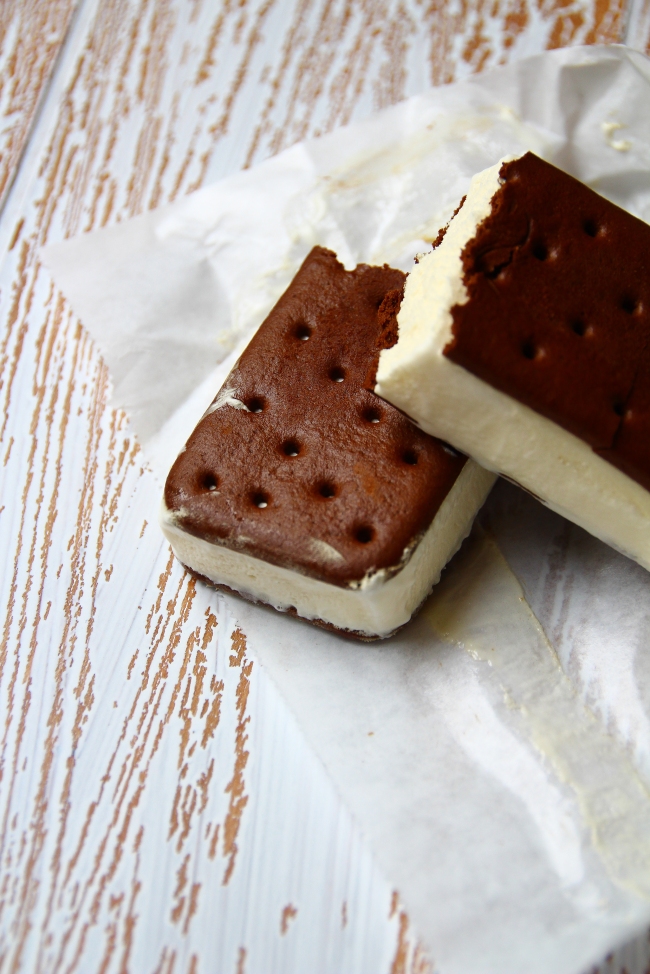 There are a thousand ways to learn new things in photography. Plenty of photographers are eager to share their tips and even more are willing to sell their tips--for a price. Honestly, the price is probably worth it. If you can find a photographer who you admire, try to take their courses and read their books. This is one way to learn photography but not the only way.
There are a thousand ways to learn new things in photography. Plenty of photographers are eager to share their tips and even more are willing to sell their tips--for a price. Honestly, the price is probably worth it. If you can find a photographer who you admire, try to take their courses and read their books. This is one way to learn photography but not the only way.Photography is about seeing better and improving your skills. When I say "seeing better," I mean improving your discerning eye. As photographers improve their skills their discerning eye has to keep one step ahead. Without a discerning eye, it's difficult to improve.
How do you train your eyes to see better?
Study photographs that look the way you want yours to look. What makes them so appealing? Is it the color, use of line, subject matter, shallow depth of field, ect.? Are there any techniques you see there that you don't know how to do? Make sure you bookmark the pages of your favorite photographers, a great site to use for this is Pinterest.
You can follow my Pinterest boards here.
Be critical when you view photos.Think about why you like them and what makes them work. This is the #1 way to improve your photography. Want to take it to the next step? Try the practice exercise below.
Practice:
1. Choose a photo from a photographer you really admire. Ask yourself these questions and write down the answers.
- What is the overall mood of the photo? Is it dark, happy, fantasy, sad?
- What is it that makes the photo appealing to you?
- What draws your eye?
- Are there any techniques that you don't know how were done?
2. Now, do this exercise for two more photos from the same photographer. What do the photos have in common?
3. Try to create a photo in the style of this photographer. You can try to reproduce an image exactly or try making an original photo in the style of this photographer. If you plan to display these, it would make good sense to attribute your inspiration.
4. Repeat with many photographers until you develop your own style. You don't want to be a carbon copy of your photography idol. Learn new tools for your photography arsenal by observing and copying then use these tools in your own way.
Welcome to Kitchenette Coquette!
This blog is designed for serious photographer amateurs. This blog is about lifestyle photography. It's about documenting your life. Like to take photos of your kids? Your food? Your kids eating food? You've come to the right place.
Here you will find:
- Ways to make your dinner look better in photos.
- General photography tips for the livin' it up kind of person.
- My thoughts on life.
- Et cetera.
I hope you:
- Learn a lot.
- Make new friends.
- Take better pictures.
Subscribe to:
Posts (Atom)

